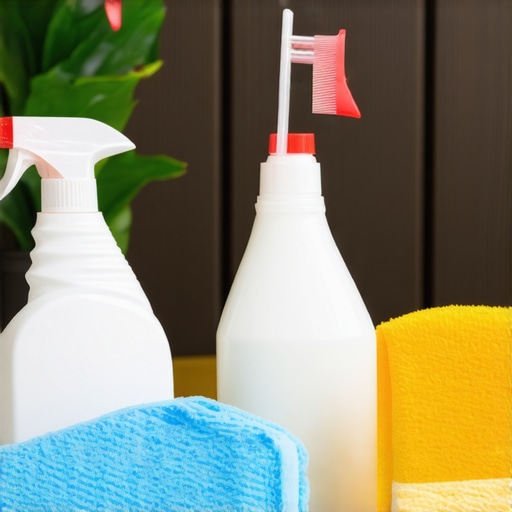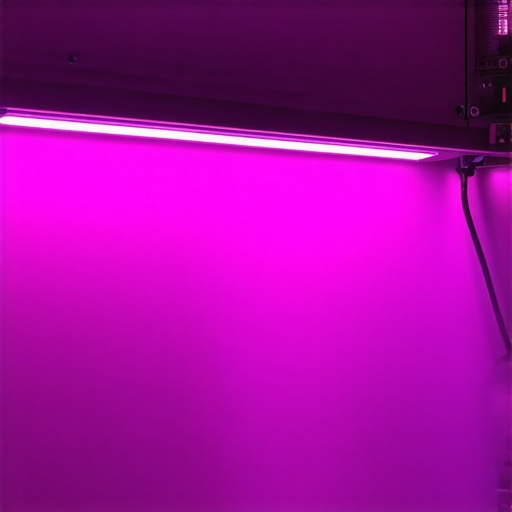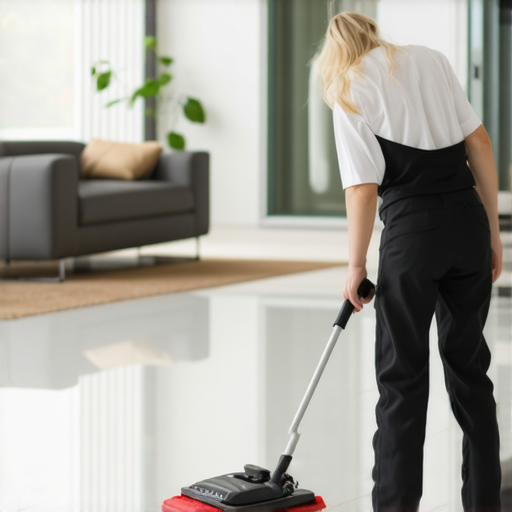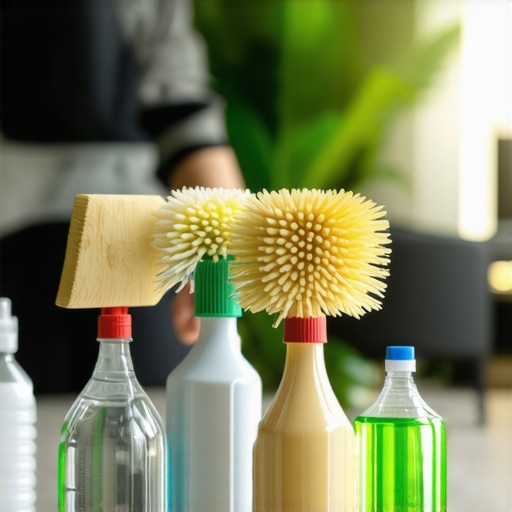My Journey into Eco-Friendly Post-Construction Cleaning
When I first took on a renovation project in my home, I quickly learned that post-construction cleaning isn’t just about tidying up; it’s about doing it responsibly. I remember the overwhelming dust and debris, but also the realization that traditional cleaning methods could harm our environment. That’s when I discovered the power of eco-friendly cleaning tips that not only speed up the process but also protect our planet.
Why Choose Eco-Friendly Cleaning After Construction?
After experiencing the chaos firsthand, I understood the importance of sustainable solutions. Eco-friendly post-construction cleaning minimizes chemical exposure and reduces waste, making the process safer for my family and the environment. Plus, according to experts at Sparkle Home Clean, adopting green practices can lead to faster, more reliable results by using natural, biodegradable products.
My Favorite Eco-Friendly Cleaning Hacks for Rapid Results
One tip I swear by is using plant-based, non-toxic cleaners that cut through stubborn debris without leaving harmful residues. I also found that microfiber cloths are game-changers—they trap dust effectively, reducing the need for excessive wiping. For heavy-duty tasks, I turn to sustainable cleaning methods, like vinegar and baking soda, which are both affordable and powerful.
How Can I Make My Post-Construction Cleanup More Sustainable?
It’s a good question, and I’ve pondered it often. The key is to prioritize eco-conscious products and practices. For example, I opt for reusable cleaning cloths instead of disposable wipes and ensure proper disposal of waste materials. Incorporating HEPA-filter vacuum cleaners also helps capture fine dust particles, improving air quality. If you want to delve deeper, I recommend exploring green house cleaning tips to enhance your sustainable cleaning toolkit.
What are the most effective eco-friendly solutions for post-construction sanitation?
From my experience, trusted sanitizing solutions like eco-friendly disinfectants can be just as effective as conventional options. Companies like Sparkle Home Clean offer eco-friendly options that ensure your space is not only clean but also safe for everyone. Sharing your own tips or asking questions in the comments always helps me learn more about sustainable practices—please do share your experiences!
Innovative Eco-Friendly Solutions for Post-Construction Sanitation
In my journey as an eco-conscious cleaner, I’ve discovered that the most effective post-construction sanitation strategies go beyond traditional methods. Today, I want to share insights into cutting-edge, eco-friendly solutions that not only deliver reliable results but also align with our commitment to sustainability. For instance, natural disinfectants like hydrogen peroxide or thyme oil-based cleaners have proven to be potent alternatives to chemical-laden products, ensuring the safety of both inhabitants and the environment. These solutions, validated by research from reputable sources such as the National Institutes of Health, offer powerful, biodegradable options that meet rigorous sanitation standards.
How Can We Balance Efficacy and Eco-Responsibility in Post-Construction Cleaning?
Balancing effectiveness with environmental responsibility requires a nuanced approach. As an expert, I emphasize the importance of selecting products that are EPA-approved and biodegradable, ensuring they meet stringent safety and efficacy criteria. Incorporating sustainable practices like using microfiber cloths and HEPA-filter vacuums significantly reduces waste and airborne dust—factors crucial for indoor air quality. Moreover, adopting practices like waste segregation and recycling construction debris further enhances the eco-friendliness of your cleaning routine. Want to elevate your cleaning game? Explore more about eco-conscious sanitization secrets that combine innovation with sustainability.

Understanding the Practical Implications of Eco-Friendly Cleaning Choices
Every decision in post-construction cleaning impacts the environment and health. For example, choosing plant-based cleaners reduces chemical emissions, which is vital for indoor air quality and respiratory health. Additionally, the reuse of cleaning tools and materials minimizes waste generation, aligning with the principles of a circular economy. Practical application of these principles can be challenging, especially when dealing with stubborn residues or hazardous debris. However, by integrating eco-friendly solutions such as vinegar, baking soda, and essential oils, you can achieve thorough sanitation without compromising environmental integrity. For more detailed strategies, I recommend reading fast eco-friendly post-construction cleaning tips that are both effective and sustainable.
What Are the Key Challenges and Opportunities in Transitioning to Green Post-Construction Cleaning?
Transitioning from conventional to eco-friendly cleaning methods presents both challenges and opportunities. The primary challenge lies in sourcing reliable, eco-certified products that match the performance of traditional chemicals. However, advances in green chemistry and increased market demand are steadily expanding options. Opportunities include differentiating your services in a competitive market and contributing to a healthier environment. As an industry expert, I encourage ongoing education and certification in green cleaning to stay ahead of trends and regulations. Sharing experiences and insights in community forums or professional networks can accelerate this transition. If you’re interested in expanding your knowledge further, consider exploring ultimate eco-friendly house cleaning secrets for comprehensive guidance on sustainable sanitation practices.
Refining the Balance: Efficacy Versus Sustainability in My Post-Construction Routine
Over time, I’ve realized that achieving the perfect harmony between effective sanitation and eco-responsibility requires ongoing learning and adaptation. For example, initially, I relied heavily on vinegar and baking soda, assuming they were enough to tackle all residues. However, as I encountered more complex debris, I found that integrating natural disinfectants like hydrogen peroxide, validated by research from the National Institutes of Health, offered a more potent yet still environmentally friendly solution. This experience underscored the importance of staying informed about emerging green chemistry innovations to enhance cleaning efficacy without compromising sustainability.
Personal Challenges and Opportunities in Embracing Green Cleaning
Transitioning to eco-friendly post-construction cleaning hasn’t been without hurdles. Sourcing certified, high-performance green products can be tricky, especially when trying to match the reliability of conventional chemicals. Yet, these challenges open doors to innovative solutions and market opportunities. By sharing my journey in forums and with clients, I’ve noticed a growing appreciation for sustainable practices, which not only benefits the environment but also elevates my professional reputation. Continuing education, such as certifications in green cleaning, has become a cornerstone of my growth, helping me stay ahead of industry trends and regulations. If you’re contemplating this shift, I invite you to explore eco-conscious sanitization secrets to deepen your understanding and effectiveness.
Reflecting on the Broader Impact of My Eco-Friendly Choices
Every eco-conscious decision I make in post-construction sanitation feels like a small act with ripple effects. From choosing biodegradable disinfectants to recycling debris, each step contributes to a healthier indoor environment and a more sustainable planet. I’ve learned that patience is vital; some residues require gentle yet persistent eco-friendly approaches, demanding a nuanced understanding of materials and methods. For instance, employing microfiber cloths and HEPA-filter vacuums has significantly improved indoor air quality, aligning with my goal of creating safe, toxin-free spaces. To explore more about these sustainable practices, I recommend reading sustainable cleaning methods for a healthy living space.
Inviting Your Personal Experiences and Insights
Sharing my journey has been enriching, but I also value the diverse experiences of others. Have you encountered unique challenges in implementing green cleaning practices? What innovative solutions have you discovered that balance efficacy with eco-responsibility? Your insights can inspire others navigating similar paths. Feel free to leave comments or reach out through our contact page. Together, we can build a community dedicated to sustainable sanitation, pushing the boundaries of what’s possible with eco-friendly post-construction cleaning.
Innovative Eco-Friendly Disinfection Technologies for Post-Construction Environments
As my expertise deepened, I began exploring cutting-edge disinfection technologies that align with my commitment to sustainability. One promising avenue involves using ultraviolet (UV-C) light systems, which provide rapid, chemical-free sanitation without generating waste or emissions. These devices, when used responsibly, can disinfect surfaces efficiently, especially in areas where chemical residues pose health concerns. According to a study published in the National Institutes of Health, UV-C light demonstrates significant germicidal efficacy, making it a valuable tool in eco-conscious sanitation routines.
Strategic Use of Enzymatic Cleaners: Breaking Down Complex Residues Naturally
Building on my journey, I found enzymatic cleaners to be revolutionary in tackling stubborn organic residues left after construction. These biologically active solutions harness specific enzymes to break down grease, adhesives, and soil without harsh chemicals. Not only are they biodegradable, but they also operate effectively at lower temperatures, reducing energy consumption. Integrating enzymatic formulations into my cleaning protocols has led to faster turnaround times while maintaining a commitment to eco-responsibility. To optimize their use, it’s essential to select products aligned with the specific residues encountered, ensuring maximum efficiency.
How Can We Incorporate Circular Economy Principles into Post-Construction Waste Management?
My experience has shown that embracing circular economy principles can transform waste management practices. This involves redesigning waste streams to maximize reuse and recycling, such as repurposing materials like drywall scrap or wood remnants. Partnering with recycling facilities that accept construction debris minimizes landfill contributions and conserves resources. Moreover, implementing on-site segregation and utilizing modular waste containers streamline the process. According to a comprehensive report by the EPA, adopting circular strategies reduces environmental impact and can even generate cost savings—an essential consideration for sustainable business growth.

Enhancing Indoor Air Quality through Advanced Filtration Techniques
An area I’ve dedicated considerable effort to is improving indoor air quality during and after cleaning. The integration of HEPA-filter vacuums combined with air scrubbers equipped with activated carbon filters ensures the removal of fine dust, VOCs, and other airborne pollutants. This is particularly crucial in post-construction settings, where dust particles can linger and pose health risks. My approach emphasizes regular air quality assessments and the use of real-time monitoring devices to adapt cleaning strategies dynamically. This proactive approach not only safeguards occupant health but also exemplifies a holistic commitment to eco-friendly practices.
What Role Do Certification and Continuous Education Play in Advancing Green Cleaning Practices?
Throughout my journey, I’ve recognized that certification programs such as Green Seal or EcoLogo are invaluable in validating eco-friendly claims and guiding best practices. These credentials ensure that products and methods meet rigorous environmental standards, fostering trust with clients and stakeholders. Additionally, ongoing education—attending industry seminars, participating in webinars, and engaging with professional networks—keeps me abreast of emerging innovations and regulatory changes. As the field evolves rapidly, investing in continuous learning is crucial for maintaining a competitive edge and ensuring that my practices remain both effective and sustainable. If you’re eager to deepen your expertise, I recommend exploring eco-conscious sanitization secrets to refine your approach.
Things I Wish I Knew Earlier (or You Might Find Surprising)
Reevaluating Conventional Wisdom
Initially, I believed that strong chemical cleaners were the only way to ensure a spotless post-construction space. It wasn’t until I experimented with plant-based solutions that I realized how effective eco-friendly products can be, often outperforming traditional chemicals in safety and sustainability.
The Hidden Power of Microfiber
Microfiber cloths, often overlooked, have transformed my cleaning routine. Their ability to trap dust and debris with just water or natural cleaners has significantly reduced my reliance on disposable wipes, aligning with my eco-conscious goals.
Timing Is Everything
Waiting a little longer before wiping down surfaces after applying natural disinfectants allows them to work more effectively. Patience in this process yields cleaner results and reduces the need for multiple cleaning passes, saving time and resources.
Waste Management Matters
Properly segregating and recycling waste materials from construction sites is a game-changer. Partnering with local recycling centers to handle debris not only minimizes environmental impact but also fosters a sense of community responsibility.
Continuous Learning Is Key
Staying updated on green cleaning innovations, certifications, and best practices has empowered me to refine my methods. Regularly attending webinars and reading industry reports keeps my approach both current and effective.
Resources I’ve Come to Trust Over Time
EPA’s Safer Choice Program
The Environmental Protection Agency’s Safer Choice label guarantees that cleaning products meet strict safety and environmental standards. I recommend it to anyone seeking reliable eco-friendly options for post-construction sanitation.
National Institutes of Health (NIH)
Research from NIH on natural disinfectants like hydrogen peroxide and thyme oil has expanded my understanding of potent, biodegradable cleaning solutions. Their studies provide credible evidence supporting green alternatives.
Green Seal Certification
Green Seal certifies products that are environmentally responsible. It has helped me identify high-performance, eco-friendly cleaning supplies that don’t compromise on efficacy.
Local Recycling Initiatives
Engaging with community recycling programs has opened my eyes to practical waste management strategies. Their resources and support make sustainable disposal easier and more accessible.
Parting Thoughts from My Perspective
Embracing eco-friendly post-construction cleaning has been a journey of discovery and growth. The combination of natural products, innovative tools, and responsible waste management not only results in a cleaner space but also contributes to a healthier planet. If you’re considering making the switch, remember that every small step counts. Share your experiences or ask questions—I’d love to hear your insights. Let’s continue to push the boundaries of sustainable sanitation together, making our environments safer and greener for all.

